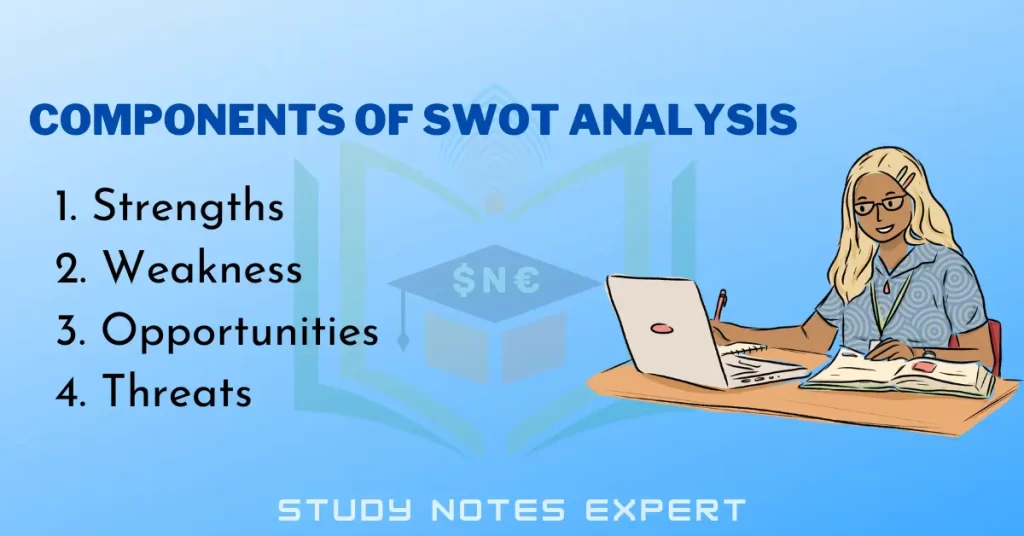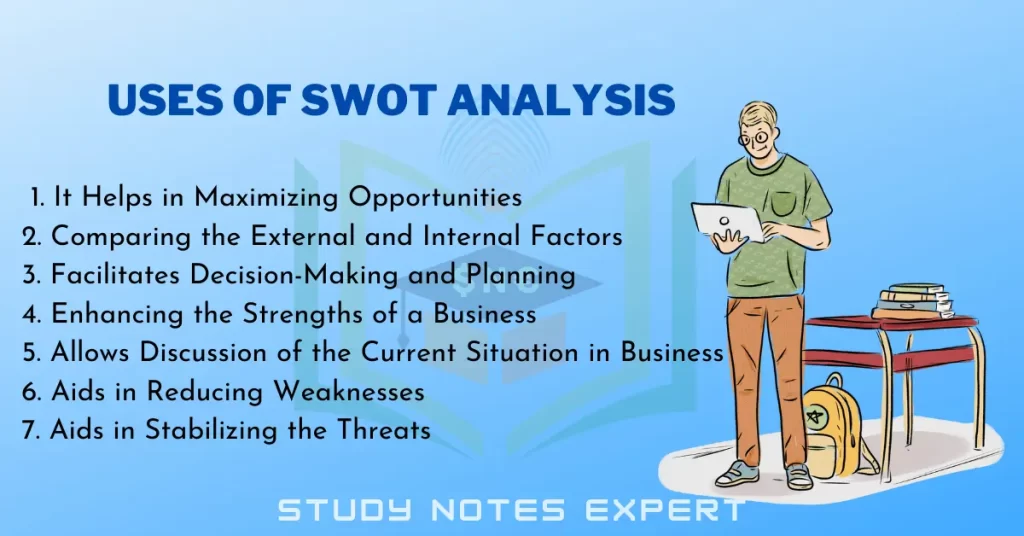“SWOT” is an acronym to mean “Strength, Weakness, Opportunities Threats” that defines the present position of a company. It determines whether a business is in a favorable or bad position in the market. Although the weaknesses and strengths are internal issues, the threats and opportunities can be external for the company. Examining all these provide a complete view to managers of the external factors that impact the company or could influence it shortly. SWOT analysis allows managers to determine the internal capabilities and resources available to tackle external factors. The analysis can also reveal shortcomings in the organization that managers must address. Therefore, SWOT analysis plays a crucial role in determining the most appropriate strategies for the business.
Parts and Components of SWOT Analysis

It comprises two principal components of SWOT analysis:
1. Internal Factors
The initial two letters of the word acronym S (strength) and the letters W (weaknesses) relate to the internal elements that comprise the resources available to the company. The internal environment is all factors under the company’s control. These elements can impact strengths that managers can use to make the most of opportunities or reasons for strategic weaknesses in the business.
i) Strengths
They are the components of SWOT analysis that provide competitive advantages for the company. Top-level management can combine these elements to enable an organization to bring about changes to the organization. These variables can differ for different companies. These could include resources and skills, among others.
ii) Weaknesses
Those factors hinder the expansion of a business or prevent the business from moving in a particular direction. They also prevent the company from reaching its goals by utilizing internal resources. The factors that hinder success vary based on the company. The definition of a weakness is any of the following: insufficient resources, lack of understanding of markets or lack of funds, etc.
It is important to remember that weaknesses and strengths are closely related as these are the components of SWOT analysis. At one point, an element may be perceived as a strength. In a different scenario, it could be a weak point. For instance, having fixed assets can serve as an organization’s strength; however, excessive fixed assets could also be a weakness since they cannot be converted into liquid cash whenever needed.
2. External Factors
These influences are outside of the organization. They are of two kinds:
i) Opportunities
A chance is a highly favorable scenario in the company’s business context. The industry must increase capacity for production to keep pace with the rising demand for domestic and international markets. Opportunities are those elements that create favorable conditions for the company. These conditions encourage organizations to expand their operations and generate greater profits. In these instances, companies adopt strategies to reap the rewards, like expanding market share on both international and domestic markets. Expanding production capacity or introducing new products, raising prices, etc.
ii) Threats
Threats are unfavorable external conditions. They can be a barrier to the company achieving its goal of achieving a market position. These elements also vary according to the company and the regions within which it operates.
Importance and Uses of SWOT Analysis

Uses of SWOT analysis in businesses are as follows:
1. Allows Discussion of the Current Situation in Business
SWOT Analysis enables organizations to analyze the current state of their business in an organized and systematic manner. It assists the strategic managers in deciding on the most appropriate strategy from the numerous options and formulating appropriate strategies.
2. Comparing the External and Internal Factors
Analyzing the external and internal factors allows managers to assess the impact of each effect on the organization as it is the importance of SWOT analysis. It helps the organization get a clear picture of the future direction of action and environmental scanning.
3. Facilitates Decision-Making and Planning
SWOT analysis is extensively utilized in decision and planning-making by managers. It allows us to think about ideas during decision-making and process planning to determine the best outcome that an organization can achieve. The SWOT analysis can be quite effective with clear and specific goals.
4. Enhancing the Strengths of a Business
Examining the internal elements gives an in-depth understanding of the company’s strengths and crucial success factors. It assists managers in enhancing and building the strength of the company.
5. It Helps in Maximizing Opportunities
The SWOT analysis identifies the opportunities in the outside environment that could arise shortly. Thus, understanding these aspects aids strategists in maximizing opportunities. Since SWOT analysis provides the internal elements that managers can use to take advantage of the opportunities for better performance.
6. Aids in Reducing Weaknesses
Highlighting weaknesses helps organizations to concentrate on eliminating or reducing their weaknesses. But, managers must remember that when cutting down on weaknesses, strategists must be practical and realistic to execute business operations efficiently.
7. Aids in Stabilizing the Threats
A thorough study of external influences allows managers to identify and identify the risks that might hinder their ability to exploit the opportunities. They can also develop efficient strategies to tackle these challenges and modify their strategies to mitigate current and future threats.
What is SWOT Analysis and Examples?
A SWOT analysis is a tool for analyzing an organization’s strengths, weaknesses, opportunities, and threats. It is typically helpful in business policy planning. The examples are skilled employees, high overhead costs, expanding into new markets, economic recession, etc.
How do you Write a SWOT Analysis?
A SWOT analysis organizes into four quadrants: internal factors (strengths and weaknesses) and external factors (opportunities and threats). When writing a SWOT analysis, start by brainstorming and writing down as many factors as possible. Then, organize the elements into four quadrants. Finally, revise the analysis to ensure that it is clear and concise.
What are 3 Major Benefits of a SWOT Analysis?
Some benefits of a SWOT analysis may include the following:
1. It helps to identify internal and external factors that are relevant to achieving an objective.
2. Help identify strengths, weaknesses, opportunities, and threats.
3. Aid generates ideas and potential solutions to identified problems.

